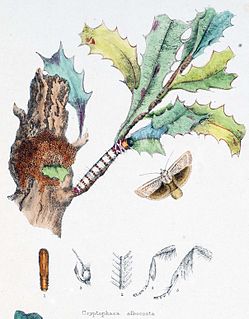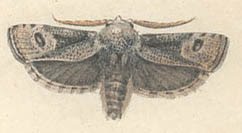Related Research Articles

Xyloryctidae is a family of moths contained within the superfamily Gelechioidea described by Edward Meyrick in 1890. Most genera are found in the Indo-Australian region. While many of these moths are tiny, some members of the family grow to a wingspan of up to 66 mm, making them giants among the micromoths.

Cryptophasa is a genus of moths of the family Xyloryctidae.
Cryptophasa crocochorda is a moth in the family Xyloryctidae. It was described by Edward Meyrick in 1925. It is found on New Guinea.
Cryptophasa leucadelpha is a moth in the family Xyloryctidae. It was described by Edward Meyrick in 1887. It is found in Australia, where it has been recorded from New South Wales, Queensland and Victoria.
Cryptophasa epadelpha is a moth in the family Xyloryctidae. It was described by Edward Meyrick in 1890. It is found in Australia, where it has been recorded from New South Wales and Queensland.
Cryptophasa rubra is a moth in the family Xyloryctidae. It was described by Edward Meyrick in 1890. It is found in Australia, where it has been recorded from South Australia, Victoria and Western Australia.
Cryptophasa sarcinota is a moth in the family Xyloryctidae. It was described by Edward Meyrick in 1890. It is found in Australia, where it has been recorded from Queensland.
Cryptophasa stochastis is a moth in the family Xyloryctidae. It was described by Edward Meyrick in 1890. It is found in Australia, where it has been recorded from Western Australia.
Cryptophasa tetrazona is a moth in the family Xyloryctidae. It was described by Oswald Bertram Lower in 1901. It is found in Australia, where it has been recorded from New South Wales, Queensland, Victoria and Western Australia.
Cryptophasa ochroleuca is a moth in the family Xyloryctidae. It was described by Oswald Bertram Lower in 1892. It is found in Australia, where it has been recorded from the Australian Capital Territory, New South Wales, South Australia and Victoria.
Cryptophasa isoneura is a moth in the family Xyloryctidae. It was described by Oswald Bertram Lower in 1902. It is found in Australia, where it has been recorded from Queensland, South Australia and Victoria.
Cryptophasa diplosema is a moth in the family Xyloryctidae. It was described by Oswald Bertram Lower in 1903. It is found in Australia, where it has been recorded from Queensland.
Cryptophasa citrinopa is a moth in the family Xyloryctidae. It was described by Oswald Bertram Lower in 1915. It is found in Australia, where it has been recorded from New South Wales and Queensland.

Cryptophasa irrorata is a moth in the family Xyloryctidae. It was described by John Lewin in 1805. It is found in Papua New Guinea and Australia, where it has been recorded from the Australian Capital Territory, New South Wales, Queensland and South Australia.
Cryptophasa melanoscia is a moth in the family Xyloryctidae. It was described by Oswald Bertram Lower in 1903. It is found in Australia, where it has been recorded from Victoria.
Cryptophasa panleuca is a moth in the family Xyloryctidae. It was described by Oswald Bertram Lower in 1901. It is found in Australia, where it has been recorded from Queensland.
Cryptophasa lasiocosma is a moth in the family Xyloryctidae. It was described by Oswald Bertram Lower in 1908. It is found in Australia, where it has been recorded from Queensland and New South Wales.
Cryptophasa psathyra is a moth in the family Xyloryctidae. It was described by Alexey Diakonoff in 1948. It is found in New Guinea.
Cryptophasa cannea is a moth in the family Xyloryctidae. It was described by Thomas Pennington Lucas in 1901. It is found in Australia, where it has been recorded from Queensland.
Cryptophasa nubila is a moth in the family Xyloryctidae. It was described by Thomas Pennington Lucas in 1894. It is found in Australia, where it has been recorded from New South Wales and Queensland.
References
- ↑ "Cryptophasa Lewin, 1805" at Markku Savela's Lepidoptera and Some Other Life Forms. Retrieved July 12, 2017.
| This article on a moth of the family Xyloryctidae is a stub. You can help Wikipedia by expanding it. |